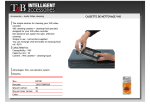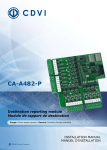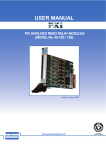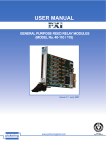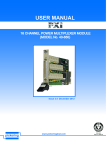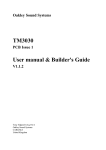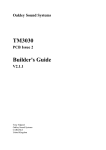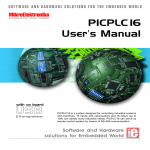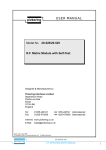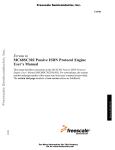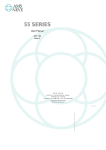Download USER MANUAL pickering - Artisan Technology Group
Transcript
USER MANUAL pickering Model No. 20-150 Power Relay Module Designed & Manufactured by:Pickering Interfaces Limited. Stephenson Road Clacton-on-Sea Essex CO15 4NL England Tel: Fax: +44 1255-687900 +44 1255-425349 Internet: www.pickeringtest.com E Mail: [email protected] Issue 6.00 Aug 2008 © Copyright (2008) Pickering Interfaces Ltd. All Rights Reserved pickering 20-150 POWER RELAY MODULE 1 HELP!!! If you need assistance with your Pickering Interfaces Switching System: Switching problems, Programming or Integration within your Test System. – Please ring Pickering Interfaces and ask for “Technical Support”. Alternatively you may fax, email or connect to our Internet Web Site. A full set of operating manuals, application notes and software drivers is available on CD ROM. pickering 2 20-150 POWER RELAY MODULE Contents Section 1 Power Relay Module.................................................................................................. 5 Section 2 Self Test .................................................................................................................... 11 Section 3 Programming ........................................................................................................... 13 Section 4 Connector Pin-Out Diagrams................................................................................... 15 Section 5 Front Panel Layout .................................................................................................. 19 Section 6 Reconfiguring Driver Card to Your Application......................................................... 21 Section 7 PCB Details / Circuit Diagrams ................................................................................ 25 pickering 20-150 POWER RELAY MODULE 3 pickering 4 20-150 POWER RELAY MODULE Section 1 Power Relay Module 1.1 Features • Up To 16 Power Relays Per Module • Choice of 13A or 30A Power Relays • Switch Up To 250V a.c. • Front Panel LED Indicators For Each Relay • 8 Additional Control Lines For Operating External Relays 1.2 Description The 20-150 range of Power Switching Modules are available with a choice of medium power 13A relays or heavy duty 30A relays. The standard version (module type 20-150-001) has 16 SPDT Power Relays which will switch up to 13A at 30V d.c. or 250V a.c. and are suitable for switching highly inductive/capacitive loads. The relay is socket mounted with the switch contact taken directly from the socket (no vulnerable PCB tracks). Further versions are available which have combinations of 13A and 30A Power Relays for applications requiring greater current capability. 20-150-001 16 x SPDT Medium Power Relays, 13 A. 20-150-201 8 x SPDT Medium Power Relays, 13A and 4 x SPST High Power Relays, 30A 20-150-101 20-150-301 12 x SPDT Medium Power Relays, 13A and 2 x SPST High Power Relays, 30A. 2 x SPDT Medium Power Relays, 13A and 8 x SPST High Power Relays, 30A 1.2.1 Connectors Connections to the 20-150 series modules are made via front panel mounted AMP CPC connectors. See Section 4 for connection details. 1.2.2 Built-in Self Test Self Test is always performed at power up and may also be exercised either by using the modules individual RS-232 interface or under program control. Any service or error indications can be diagnosed using the DIAGNOSTIC? command, refer to Section 2 for further details. 1.2.3 Front Panel A typical front panel is comprised of four elements, please refer to Fig 1.2. Status Display, 5 LED Indicators:- Power LED. Connected to system power supply. Active LED. On whenever one or more relays are selected. Use the VIEW? command for a list of all active channels. Self-Test LED. Active while the self-test is in progress. Warning LED. Indicates that the self test has detected a relay parameter drifting towards out of range. Error LED. Indicates that an error was found during self-test. Internal RS-232 Connector. Allows the module to be connected to a terminal or PC via the serial cable provided to enable configuration details to be set up by the user. Switch Contact Connectors, AMP CPC connectors. Relay Status Indicators, Each relay has its individual LED status indicator which is on when the relay is energised. 1.2.4 Width and Dimensions The Power Relay Module conforms to the 6U height (262mm) Eurocard standard and is housed in a 160mm deep screened plug-in module. Panel width is 15HP (3.0 inches, 76.2mm). This is a double height module and must be mounted into a double height (6U) case. pickering 20-150 POWER RELAY MODULE 5 20-110 Power Relays Product No. of Medium Code Power Relays 20-150-001 16 20-150-101 No. of High Power Relays 12 20-150-201 20-150-301 0 2 8 2 4 8 Table 1.1 20-150 Order codes 1.3 SPDT Medium Power Switch A summary of the capability of these modules is given in table 1.2. Contact Type AgCdO Contact Current Rating Resistive Load 13A at 250V a.c. 13A at 30V d.c. 13A at 250V a.c. 5A at 30V d.c. 5A at 30V d.c. Inductive Load Max Standoff Voltage Max Switching Voltage Max Switch Current Max Carry Current Contact Resistance On: Off: Bandwidth (50Ω) 600V d.c. 250V r.m.s. 13A 13A Max Operate Time† Max Relay Close Settling Time Max Relay Open Settling Time Expected Life (Operations) Low power load Full power load 1 5 0 mΩ > 108 Ω 10MHz 15ms 10ms 7ms > 107 > 105 † This is the time taken from the start of the IEEE-488 or RS-232 message to the closure of the relay (assuming fast IEEE-488 / RS-232 communication and no pending operations. Table 1.2 Medium Power Relay Specifications 6 pickering 20-150 POWER RELAY MODULE 1.4 SPST High Power Switch A summary of the capability of these modules is given in table 1.3. Contact Type Silver Alloy Contact Current Rating Resistive Load 30A at 250V a.c. 30A at 30V d.c. Max Standoff Voltage Max Switching Voltage Max Switch Current Max Carry Current Contact Resistance On: Off: Bandwidth (50Ω) 600V d.c. 270V a.c. r.m.s. 30A 30A Max Operate Time† Max Relay Close Settling Time Max Relay Open Settling Time Expected Life (Operations) Low power load Full power load 5m Ω > 10 8 Ω 10MHz 30ms 20ms 5ms > 5 x 106 > 105 Table 1.3 High Power Relay Specifications 1.5 Digital Output Lines A summary of the capability of these modules is given in table 1.4. Device Type Output Type Max Standoff Voltage Max Sink Current Max Power Each Output Max Power All Outputs ULN2803 Open Collector Driver 50V 500mA 1.0W 1.6W Table 1.4 Digital Output Specifications pickering 20-150 POWER RELAY MODULE 7 B1 A1 C1 B1 A1 C1 13A B2 A2 C2 B2 A2 C2 13A B3 A3 C3 13A B3 A3 C3 13A B16 A16 C16 13A B2 A2 C2 B3 A3 C3 13A 13A A9 C9 A10 C10 A11 13A C11 A14 30A C14 13A 20-150-101 20-150-001 B1 A1 C1 30A C13 13A B12 A12 C12 13A A13 30A 30A B1 A1 C1 B2 A2 C2 13A 13A A3 C3 A4 C4 A5 30A C5 30A 30A 30A A12 B8 A8 C8 C12 30A A10 13A C10 20-150-201 20-150-301 Fig 1.1 Power Relay Schematics 8 pickering 20-150 POWER RELAY MODULE 30A Fig 1.2 Standard 20-150-001 Power Switch Module pickering 20-150 POWER RELAY MODULE 9 pickering 10 20-150 POWER RELAY MODULE Section 2 Self Test 2.1 Self-Test Function Self-Test is invoked at power on and may also be operated under software control using the *TST? command. If the SelfTest fails the Error LED on the front panel will be turned on. Any test parameter that is seen from previous test data to be drifting towards out of specification, but does not at present warrant an error alarm, will turn on the Service LED on the front panel. A full pass/fail description is available using the DIAGNOSTIC? command. Self-Test comprises 3 levels, see Fig 2.1:1. Logic Test: Checks all logic including on-board microprocessor RAM, ROM, and EEPROM, relay drivers etc. 2. Analogue Test: Checks voltage levels are correct for all the power supplies and front panel LED's. 3. Relay Coil Test: The resistance of all relay coils are checked. Note: In the unlikely event of a relay needing replacement additional relays are available from Pickering Interfaces. 2.2 Self-Test Operation Self Test is always run at power on, taking approximately 5 seconds. If self test is run under software control it will firstly clear the whole module . So it is very important to prepare your external instruments and U.U.T. for this! During self-test all switches are opened so your external circuitry will see only very high resistance inputs. When the self-test has finished the relays will be returned to an all clear state (i.e. the previous state will not be remembered!). Please note that because of the long self-test time your computer may time out waiting for the test result (many PC's have default timeouts set to 10 seconds). 2.3 Configuring Self Test Self Test may be configured so that some or all of the test functions can be disabled. This is achieved by setting the appropriate bit in the test configuration byte. Refer to Section 6 for details on how to reconfigure the driver card to your application. 2.4 Detailed Self Test Reporting using the DIAGNOSTIC? Query The DIAGNOSTIC? query will give an ASCII string detailing any self test failures. These will include:Logic: µP, RAM, EPROM, Relay Drivers, Invalid Link Settings etc. Analogue: 5 Volt supply low etc. Relay Coils: Open Circuit Coil. This string is not intended to be processed by the user’s software, it is suitable for copying directly onto the screen of your control computer. This information will then indicate maintenance required (please contact Pickering for further help). pickering 20-150 POWER RELAY MODULE 11 SELF TEST INITIATED BY: . POWER ON . *TST? INTERFACE CMND . TS 1 RS232 COMMAND CLEAR MODULE MEMORY and LOGIC TEST Yes LOGIC TEST FAIL ? No ANALOGUE TEST Yes ANALOGUE TEST FAIL ? No RELAY COIL TEST Yes RELAY COIL TEST FAIL ? No SELF TEST PASS SELF TEST FAILURE ERROR LED ON USE DIAGNOSTIC? COMMAND Fig 2.1 Self-Test: Basic Flow Diagram pickering 12 20-150 POWER RELAY MODULE Section 3 Programming 3.1 Select Module Address The module internal address is factory pre-set, please refer to case schematic diagram at front of manual. To change the internal address please refer to section 6, Reconfiguring Driver Card to Your Application. 3.2 Programming Using the Intelligent GPIB/RS-232 Interface The 20-150 module is simple to program either by single bit, byte (8 bits) or word (16 bits). ARESET a Clear all outputs on module a CLOSE a,b Set bit number b on module a DELAY t Force a minimum delay of t milliseconds between two instructions OPEN a,b Clear bit number b on module a RESET Clear all bits/switches on all modules SIZE sThis is used to specify the word size: s = 1 for byte, s = 2 for 16 bit word and s = 3 for 32 bit word (16 bit is usually the factory default). VIEW? a[,b] View status of module a, can be viewed at any time either as a word or by bit b as a logical value (1 or 0) WRITE a,c,w Send word w to module a block position c The module is programmed as an 8 bit output port using either single bit, byte (8 bits), or 16 bit word:To close relay number 5 on module 11. CLOSE 11,5 Or to close first 16 relays on module 8. SIZE 2 (this selects byte length words) WRITE 8,1,65535 For more details on programming see the programming manual for the IEEE-488.2/RS-232 interface module. 3.3 Operating Speed Multiplexer operating speed, i.e. the time taken to open or close a channel, is approximately 10mS using the 10-921 IEEE488.2/RS-232 interface module. pickering 20-150 POWER RELAY MODULE 13 pickering 14 20-150 POWER RELAY MODULE Section 4 Connector Pin-Out Diagrams Connector A Front Panel Description Pin No. 1 Digital Com. 2 Digital Gnd. 3 Digital O/p 1 4 Digital O/p 2 5 Digital O/p 3 6 Digital O/p 4 7 Digital O/p 5 8 Digital O/p 6 9 Digital O/p 7 10 Digital O/p 8 11 not used 12 not used 13 not used 14 not used 15 not used 16 RL1 no 17 RL1 com 18 RL1 nc 19 RL2 no 20 RL2 com 21 RL2 nc 22 RL3 no 23 RL3 com 24 RL3 nc Connector B Front Panel Pin No. 1 2 3 4 5 6 7 8 9 10 11 12 13 14 15 16 17 18 19 20 21 22 23 24 Description RL4 no RL4 com RL4 nc RL5 no RL5 com RL5 nc RL6 no RL6 com RL6 nc RL7 no RL7 com RL7 nc RL8 no RL8 com RL8 nc RL9 no RL9 com RL9 nc RL10 no RL10 com RL10 nc RL11 no RL11 com RL11 nc Connector C Front Panel Pin No. 1 2 3 4 5 6 7 8 9 10 11 12 13 14 15 16 17 18 19 20 21 22 23 24 Description RL12 no RL12 com RL12 nc RL13 no RL13 com RL13 nc RL14no RL14 com RL14 nc RL15 no RL15 com RL15 nc RL16 no RL16 com RL16 nc not used not used not used not used not used not used not used not used not used Fig 4.1 20-150-001 CPC Connector Pin Out Diagram. pickering 20-150 POWER RELAY MODULE 15 Connector A Front Panel Description Pin No. 1 not used 2 Digital Com. 3 Digital Gnd. 4 Digital O/p 1 5 Digital O/p 2 6 Digital O/p 3 7 Digital O/p 4 8 Digital O/p 5 9 Digital O/p 6 10 Digital O/p 7 11 Digital O/p 8 12 not used 13 RL1 no 14 RL1 com 15 RL1 nc 16 RL2 no 17 RL2 com 18 RL2 nc 19 RL3 no 20 RL3 com 21 RL3 nc 22 not used Connector B Front Panel Pin No. 1 2 3 4 5 6 7 8 9 10 11 12 13 14 15 16 17 18 19 20 21 22 Description RL13 no RL4 no RL4 com RL4 nc RL5 no RL5 com RL5 nc RL6 no RL6 com RL6 nc RL7 no RL7 com RL7 nc RL8 no RL8 com RL8 nc RL9 no RL9 com RL9 nc not used not used RL13 com Connector C Front Panel Pin No. 1 2 3 4 5 6 7 8 9 10 11 12 13 14 15 16 17 18 19 20 21 22 Description RL14 no RL10 no RL10 com RL10 nc RL11 no RL11 com RL11 nc RL12no RL12 com RL12 nc not used not used not used not used not used not used not used not used not used not used not used RL14 com Fig 4.2 20-150-101 CPC Connector Pin Out Diagram. Connector A Front Panel Description Pin No. 1 RL3 com 2 Digital Com. 3 Digital Gnd. 4 Digital O/p 1 5 Digital O/p 2 6 Digital O/p 3 7 Digital O/p 4 8 not used 9 Digital O/p 5 10 Digital O/p 6 11 Digital O/p 7 12 Digital O/p 8 13 not used 14 not used 15 RL1 no 16 RL1 nc 17 not used 18 RL2 no 19 RL2 nc 20 RL1 com 21 RL2 com 22 RL3 no pickering 16 Connector B Front Panel Pin No. 1 2 3 4 5 6 7 Description RL4 com RL4 no RL5 com RL5 no RL10 com RL6 com RL6 no Connector C Front Panel Pin No. 1 2 3 4 5 6 7 Description RL7 com RL7 no RL8 com RL8 no RL10 no RL9 com RL9 no Fig 4.3 20-150-301 CPC Connector Pin Out Diagram. 20-150 POWER RELAY MODULE Connector A Front Panel Pin No. 1 2 3 4 5 6 7 8 9 10 11 12 13 14 15 16 Connector B Description Not used Digital Com. Digital Gnd. Digital O/p 1 Digital O/p 2 Digital O/p 3 Not used Digital O/p 4 Digital O/p 5 Not used Digital O/p 6 Digital O/p 7 Digital O/p 8 Not used Not used Not used Connector C Front Panel Pin No. Description Front Panel Pin No. 1 2 3 4 5 6 7 8 9 10 11 12 13 14 15 16 RL9 com RL1 no RL1 com RL1 nc RL2 no RL2 com RL9 no RL2 nc RL3 no RL10 com RL3 com RL3 nc RL4 no RL4 com RL10 nc RL4 no 1 2 3 4 5 6 7 8 9 10 11 12 13 14 15 16 Description RL11 com RL5 no RL5 com RL5 nc RL6 no RL6 com RL11 no RL6 nc RL7 no RL12 com RL7 com RL7 nc RL8 no RL8 com RL12 nc RL4 no Fig 4.4 20-150-201 CPC Connector Pin Out Diagram. pickering 20-150 POWER RELAY MODULE 17 POW Connector A Connector B Connector C 20-150-001 Power Relay Module ACT POW Connector A ACT POW Connector A POW Connector A ACT ACT TEST TEST TEST TEST ERR ERR ERR ERR MAN TEST MAN TEST Connector B Connector C 3.0" Connector B Connector C 20-150-101 Power Relay Module 3.0" MAN TEST Connector B MAN TEST Connector C 20-150-201 Power Relay Module 20-150-301 Power Relay Module 3.0" 3.0" Shell type 23 - 24 Shell type 23 - 22M Shell type 23 - 7 Shell type 23 - 16M Connector Utilisation 20-150-001 = 3 x 23-24 20-150-101 = 3 x 23-22M 20-150-201 = 3 x 23-16M 20-150-301 = 2 x 23-7 + 1 x 23-22M Fig 4.5 CPC Connectors used in 20-150 Series modules. 18 pickering 20-150 POWER RELAY MODULE Section 5 Front Panel Layout A POW ACT TEST ERR WARN CONF B C Fig 5.1 Front Panel Layout for 20-150-001 using 24 Way CPC Connectors. pickering 20-150 POWER RELAY MODULE 19 pickering 20 20-150 POWER RELAY MODULE Section 6 Reconfiguring Driver Card to Your Application 6.1 Driver Card Configuration The module is configured using the internal RS-232 Serial port connected via the 4 pin Datamate connector on the front panel with the supplied lead. Configuration data is stored within the module in EEPROM and may be altered using a dedicated terminal or a computer terminal program, set up as follows; Baud rate 9600 8 Data bits 1 Stop bit No parity. There are three groups of commands available via the internal RS-232 interface which are used to operate and configure the module. The groups are; 1. User Instruction Set: Commands to operate switches, provide relay status and module information. 2. Configuration Instruction Set: Commands to set up the module to a specific configuration. 3. Factory Instruction Set: Commands to set the module self test limits. All instructions must be entered as shown for the command to operate correctly. 6.2 User Instruction Set Command Relay Block Ascii BL Bytes 8 bytes of data Description Example 64 bit block of relay data. Block View? BV View status of all relays. Diagnostic? DI Report self test errors. Dump DU 0 Relay test history dump. DU 0 1 Dump even if data is invalid. DU 1 Close CL relay Close a relay contact. CL 7. Close CL bank,channel Close a MUX channel. CL 1 4. Close CL x axis, y axis Close a matrix crosspoint. CL 7 3. Open OP relay Open a relay contact. OP 7. Open OP bank,channel Open a MUX channel. OP 1 4. Open OP x axis, y axis Open a matrix crosspoint. OP 7 3. Reset RS Reset all relays to off. Service? SR Report all service warnings. Test TS 0 Return result of last self test. TS 0 1 Initiate self test and return result. TS 1 Type? TY Returns module type data string. Who? WH Module introduction string. MUX Clear XC pickering bank Reset an individual mux bank. XC 01. 20-150 POWER RELAY MODULE 21 6.3 Configuration Instruction Set The Configuration instruction allows a module to be set up for a specific application by setting up its address, bank and self test options etc.. To view the current configuration settings without altering any parameters simply type "CF". Config Command Ascii Bytes CF 1 x CF 3 x CF CF 2 x 4 0 Description x = Number of multiplexer banks in module. x = Number of pods in module. Switch Mode For I/O Modules mode is always 0. 0 or 1 CF 5 CF 6 CF 0 or 1 0 1 7 Example x = Module address. MUX modules, 0 = normal, 1 = multi channel Matrix modules, 0 = RF, 0 or 1for others. Switch Type. Ruthenium. CF 1 5 CF 2 4 CF 3 0 CF 4 0 CF 4 1 CF 5 0 Mercury. CF 5 1 Panel Width. For future use. Selftest Options Each bit enables a specific test. Bit 0 = Spare. LSB. Bit 1 = RAM test. Bit 2 = Panel LED test. Bit 3 = Coil test. Bit 4 = LED test. Bit 5 = Switch Contact test. Bit 6 = Temperature test. Bit 7 = Selftest at start up. MSB. Standard Configuration setup. CF 8 Module data 1 CF 10 Module data 3 CF 12 CF CF 9 11 Module data 2 Module data 4 Configuration mode Module data is dependent upon Module type as follows; Module data byte 1 2 3 4 CF 7 125 I/O Module MUX Module Matrix Module Bits out start Start Y Size Bits Out Bits in Not used Size Not used Not used X Size X Start Y Start Configuration modes for the 20-150 series of modules are; CF 12 1 20-150-001 module. CF 12 3 20-150-201 module. CF 12 2 CF 12 4 22 pickering 20-150-101 module. 20-150-301 module. 20-150 POWER RELAY MODULE 6.4 Factory Instruction Set The Factory Instruction Set is used to set the selftest threshold levels for the 20-150 series of modules. The parameters are shown for information only and should not be altered without contacting Pickering Interfaces as they are primarily for factory use only. Limit Command Ascii Description Default ZL 1 Minimum coil threshold. ZL 1 32 ZL 3 Contact closed error threshold. ZL 3 69 ZL ZL ZL ZL ZL 2 4 5 6 7 Maximum coil threshold. ZL 2 144 Contact closed service threshold. ZL 6 136 Fail temperature threshold. ZL 7 168 8 5V low threshold. ZL 10 Maximum LED voltage threshold. ZL ZL ZL ZL ZL ZL 9 11 12 13 14 15 16 ZL 5 128 Service temperature threshold. ZL ZL ZL 4 48 Contact open error threshold. ZL 8 244 Minimum LED voltage threshold. ZL 13 160 ZL 14 208 Minimum Panel LED voltage threshold. ZL 15 128 Maximum Panel LED voltage threshold. ZL 16 176 12V high threshold. ZL 10 240 12V low threshold. ZL 9 192 Selftest retries before failure. ZL 11 3 Settled delay, in 10us. ZL 12 25 (250us) 6.5 Link Settings The links on the PCB are set at the factory to configure the module for the specific type of 20-150 series of modules. The information is shown for information only and should not need to be altered. Link Settings for Power Module Options LK2 LK3 LK2 LK3 LK4 LK5 LK4 LK5 20-150-001 16 x 16 Amp Relays 12 x 16 Amp Relays 2 x 30 Amp Relays LK2 LK3 LK2 LK3 LK4 LK5 LK4 LK5 20-150-201 8 x 16 Amp Relays 4 x 30 Amp Relays pickering 20-150-101 20-150-301 2 x 16 Amp Relays 8 x 30 Amp Relays 20-150 POWER RELAY MODULE 23 pickering 24 20-150 POWER RELAY MODULE Section 7 PCB Details / Circuit Diagrams +5V R16 47K 2 +Vs 3 Vo GND 1 U11 U10 2 8 3 TST1 7 10 K 4 +5V 6 5 V+ 2+ 6 2- 3 RACK ADDRESS 1 (28a) RACK ADDRESS 2 (28c) V- 11 10 3+ 3- 9 7 8 R18 LM2902D 12K R19 2 RACK ADDRESS 0 (27c) LM45 13 412 4+ 11+ 5 4 14 1 R15 9 R3 R4 10M 10K 10K R3 1 100 R R1 COM R17 R14 12K +5V 5V 5V 5V C1 C2 25 pF 25 pF RLA (26a) R22 (25c) SLOT ADDRESS 2 100K SLOT ADDRESS 1 R6 X1 (25a) 10K LK1 Emulation SLOT ADDRESS 0 10K R5 SLOT ADDRESS 3 (26c) RESIN SENSE 3 GND RST -RST PE2 PE6 PE3 PE7 VRL VRH MODB Vss STRA PB2 PC6 PB3 PC7 PB4 RESET PB5 XIRQ/Vpp PB6 PB7 PD0 PA0 PA1 IRQ 8 7 68HC711E9 46 45 44 43 1 42 2 41 3 40 4 39 5 38 6 37 7 36 8 35 9 34 10 U4 *OE1 VCC A0 *OE2 A1 Y0 A2 Y1 A3 Y2 A4 Y3 A5 Y4 A6 Y5 A7 Y6 GND Y7 20 19 R21 16 ACTIVE LED 1 18 15 TEST LED 17 2 16 3 14 WARNING LED 15 4 13 ERROR LED 14 5 12 13 6 11 12 7 10 11 8 9 INH 21 22 23 24 25 26 27 28 29 30 31 32 33 6 5V 5 TL7705 10 uF Q6 U4 (13a) C5 6 T1out C2+ R1in C2- R1out T1in V- 7 T2out 8 R2in T2in R2out +12V 14 13 5V 12 11 10 Q3 9 Q2 MAX232A Q1 2SJ174 5V R9 5 C1- 15 12 K 4 16 1K 3 C9 Vcc GND V+ R8 C1+ 2 R2 1 C8 STLD BS870 C6 C7 R20 10 K RDATA 1 RDATA 2 STRB 1 RDATA TEST +5V STRB 2 TX LCLK RX STRB TEST 5V 1 2 3 4 LDATA 100nF CT 4 C3 PB1 PC5 10K 2 C4 Vcc R15 Vref PB0 U1 PC4 U2 1 MODA EXTAL PC3 PD1 20 PE0 PA2 19 PE4 PC2 PA3 18 PC1 PA4 17 PE1 PA5 16 PE5 PC0 PA6 R14 10K 10K R13 15 1 52 51 50 49 48 47 PA7 14 2 Vdd 13 3 PD5 12 4 PD4 11 5V 5 PD3 9 10 6 XTAL PD2 8 E 7 (27a) STRB SLOT ADDRESS 4 2SJ174 LED SUPPLY RELAY SUPPLY 470 k R10 R11 Q5 330 K R17 1K R16 470R BC182L R18 Q4 470R BS870 SPI bus. BS870 Backplane pin connects in brackets (10c) BMISO U3.B MOSI 3 74HCT14 4 U3.C 5 6 (11a) U3.F SCK 13 U3.E 12 11 10 (11c) U3.A SS 1 U3.D 2 9 LED Resistors R23 - R30 5V 8 LED Resnets R31 - R37 (13c) 470R 470R Note. LK1 is broken when using the Nohau emulator 14 20 C6 U3 U4 7 10 C7 C8 C9 C10 150uF All decouplers 100nF Pickering Interfaces Ltd. Title E9 Controller Circuit Drawn K i m Grant Date 12-5-95 1 of 1 Fig 7.1 Driver Circuit Diagram pickering 20-150 POWER RELAY MODULE 25 Relay Number on Connector Reference on PCB Relay Number on Connector RL1 RL2 RL3 RL4 RL5 RL6 RL7 RL8 1 2 3 4 5 6 7 8 Reference on PCB RL9 RL10 RL11 RL12 RL13 RL14 RL15 RL16 9 10 11 12 13 14 15 16 SIMM SOCKET RL2 RL1 RL4 RL3 RL8 RL7 RL6 RL5 RL12 RL11 RL10 RL9 RL16 RL15 RL14 RL13 Fig 7.2 20-150-001 Board Layout Diagram. 26 pickering 20-150 POWER RELAY MODULE Relay Number on Connector Reference on PCB RL1 RL2 RL3 RL4 RL5 RL6 RL7 1 2 3 4 5 6 7 Reference on PCB Relay Number on Connector RL8 RL9 RL10 RL11 RL12 RL23 RL24 8 9 10 11 12 13 14 SIMM SOCKET RL2 RL1 RL4 RL3 RL8 RL7 RL6 RL5 RL12 RL11 RL10 RL9 RL23 RL24 Fig 7.3 20-150-101 Board Layout Diagram. pickering 20-150 POWER RELAY MODULE 27 Relay Number on Connector Reference on PCB Relay Number on Connector 1 2 3 4 5 6 RL1 RL2 RL3 RL4 RL5 RL6 7 8 9 10 11 12 Reference on PCB RL9 RL10 RL21 RL22 RL23 RL24 SIMM SOCKET RL2 RL8 RL1 RL4 RL3 RL7 RL6 RL5 RL22 RL21 RL24 RL23 Fig 7.4 20-150-201 Board Layout Diagram. 28 pickering 20-150 POWER RELAY MODULE Relay Number on Connector 1 2 3 4 5 Reference on PCB Relay Number on Connector RL1 RL2 RL17 RL18 RL19 Reference on PCB RL20 RL21 RL22 RL23 RL24 6 7 8 9 10 SIMM SOCKET RL2 RL1 RL18 RL17 RL20 RL19 RL22 RL21 RL24 RL23 Fig 7.5 20-150-301 Board Layout Diagram. pickering 20-150 POWER RELAY MODULE 29 30 pickering 20-150 POWER RELAY MODULE Section 8 Power Relay Data Sheets pickering 20-150 POWER RELAY MODULE 31 32 pickering 20-150 POWER RELAY MODULE

































